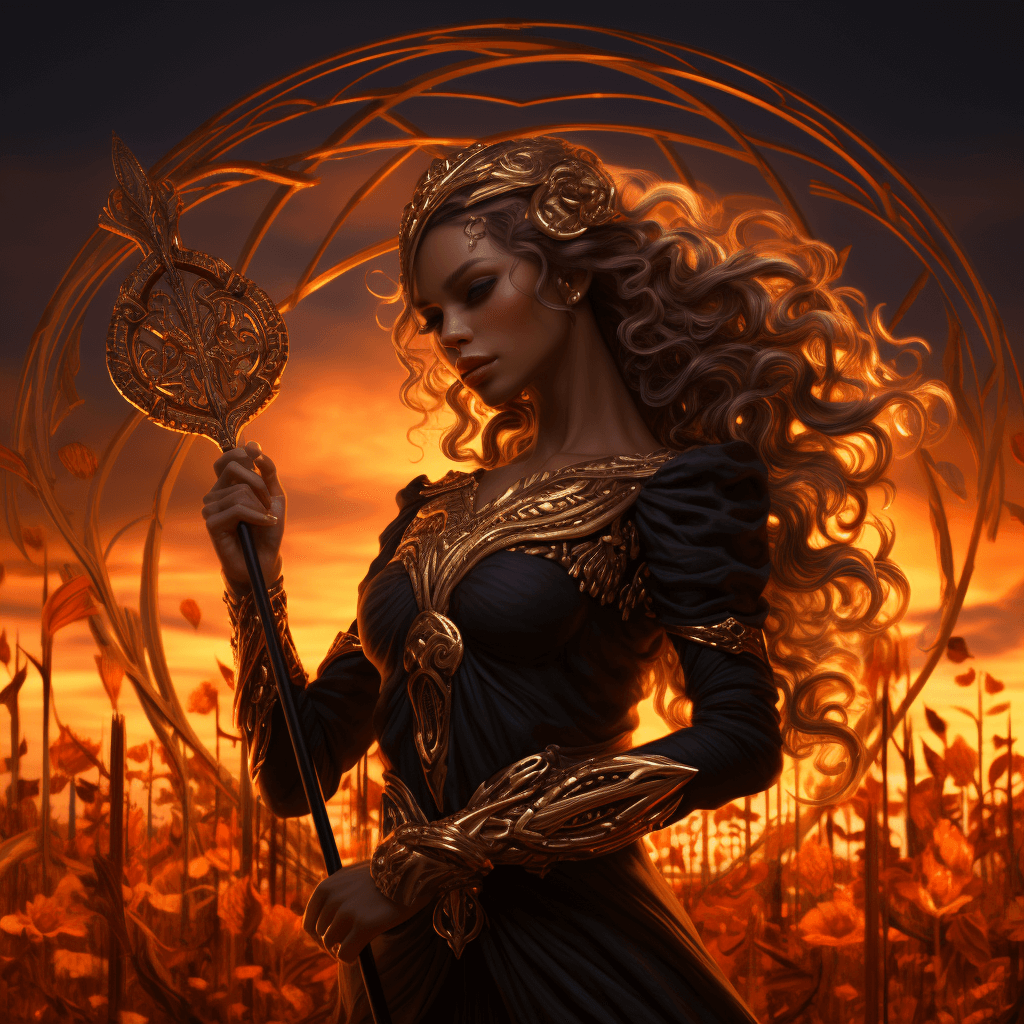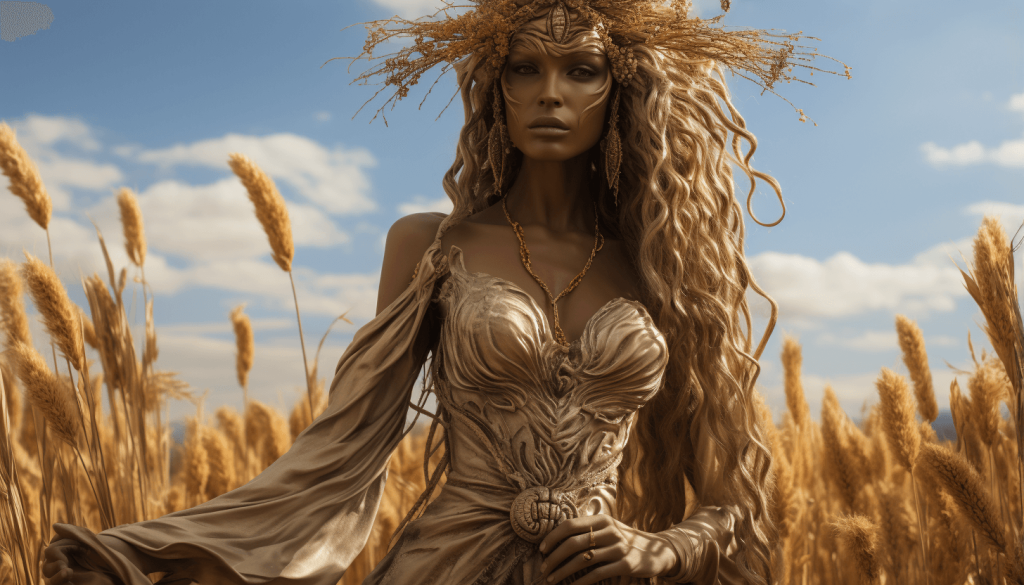Demeter: Goddess of the Harvest
Among the pantheon of ancient Greek deities, Demeter stands out as the emblematic figure of nature’s bounty. Not just any force of nature, but specifically the fruitful yield of the earth—the grains, the harvest, and the very cycle of life and death. To truly appreciate her significance, it’s crucial to delve deep into her origins.
Demeter’s Origins: Tracing the Birth of the Harvest Goddess
Demeter’s name, often translated as “Mother Earth,” reveals her fundamental nature. Rooted in ancient Greek traditions, her persona evolved over the centuries, encompassing the hopes and fears of agrarian societies dependent on the unpredictable whims of nature.
- Birth in the Time of Titans: Born to the Titan deities Cronus and Rhea, Demeter was one of the Olympian gods’ earliest members. Her siblings, notable figures such as Zeus, Hera, and Poseidon, played significant roles in Greek myths, indicating the prominence of this divine family.
- The Grain-Giving Deity: From early on, Demeter was revered as the deity responsible for the fertility of the land. Her essence was intertwined with the cycles of planting and harvesting, making her indispensable to the agrarian societies of ancient Greece.
- Crete: A Potential Birthplace: While many associate Demeter with mainland Greece, some legends hint at her origins being in Crete. This island, rich in myth and history, has its own tales of a grain deity, suggesting that the stories of Demeter might have been influenced or even originated there.
It’s fascinating to see how Demeter’s story, like the grains she governs, has roots that run deep and spread wide. Her origins not only shed light on her significance but also offer a window into the very fabric of ancient Greek culture and its relationship with nature.
But what symbols represented this influential goddess? How did the ancients depict and honor her? These questions guide us to the next chapter of our journey, where we explore the symbols and icons uniquely associated with Demeter.
Demeter, a pivotal figure in Greek mythology, symbolized earth’s fertility as the Goddess of the Harvest. Daughter of Titans Cronus and Rhea, she embodied the vital connection between humanity and nature, influencing agrarian societies deeply reliant on nature’s cycles.
Symbols of Demeter: Unraveling Their Meanings
In the vast tapestry of Greek mythology, symbols often held profound meanings, acting as direct conduits to the essence of deities. Demeter, revered for her connection with the earth and agriculture, is frequently represented by various symbols, each reflecting different facets of her divine nature.
| Symbol | Description | Significance |
|---|---|---|
| Sickle | A curved blade used primarily for harvesting crops. | The sickle, reminiscent of the crescent moon, represents Demeter’s role in agriculture and the cyclical nature of life. It signifies harvest, rejuvenation, and the unending loop of sowing and reaping. |
| Grains | Specifically wheat or barley depicted in various artworks. | Grains are a direct symbol of fertility, sustenance, and the nourishment Demeter provides to the world. They underscore her dominion over agriculture and her pivotal role in human sustenance. |
| Torch | A flaming torch, often shown in contexts related to her daughter, Persephone. | The torch illuminates Demeter’s relentless quest for her abducted daughter and symbolizes hope, determination, and the enduring bond between mother and child. |
The Eleusinian Mysteries: Unveiling the Sacred Secrets of Demeter

The ancient world, with its myriad of gods and rituals, held a special place for the Eleusinian Mysteries – secretive rites dedicated primarily to Demeter and her daughter, Persephone. Originating in the city of Eleusis, these ceremonies played a pivotal role in Greek religion, offering participants profound spiritual experiences and insights into the mysteries of life and death.
Historical Context
Eleusis, a city near Athens, became the epicenter of the Eleusinian Mysteries. It was believed that Demeter, in her grief-stricken wanderings after the abduction of Persephone by Hades, took refuge in Eleusis. There, she taught the locals the art of agriculture, symbolizing the cyclical nature of life and death.
Ritual Phases
- Myesis: The initial phase where initiates were introduced to the mysteries. They underwent purification rites and were taught the foundational myths of Demeter and Persephone.
- Telete: This phase involved more elaborate ceremonies, which were shrouded in secrecy. Initiates participated in various rites, possibly involving symbolic reenactments of the Demeter and Persephone myth.
- Epopteia: The climax of the initiation process. Little is known about the specifics of this stage due to the stringent vow of silence imposed on participants. However, it’s widely believed that initiates experienced profound spiritual revelations during this phase.
The Veil of Secrecy
Details of the Eleusinian Mysteries remain largely enigmatic. Participants were sworn to absolute secrecy, under the threat of severe penalties. This cloak of silence has preserved the sanctity and allure of the mysteries for millennia, making them one of the most intriguing aspects of ancient Greek religion.
Legacy and Influence
Despite the secrecy, the influence of the Eleusinian Mysteries transcended ancient Greece. Philosophers, writers, and thinkers have drawn inspiration from these rites, seeing them as pathways to understanding the profound mysteries of existence. Even today, the allure of these ancient ceremonies continues to captivate our imaginations, beckoning us to delve deeper into the enigmatic world of Demeter and Persephone.
Demeter’s Relationships: Bonds with Other Olympian Gods and Goddesses
The pantheon of ancient Greek gods teemed with intricate relationships, betrayals, alliances, and rivalries. Demeter, the nurturing Goddess of the Harvest, was no exception. As she interacted with fellow Olympian deities, her relationships shed light on her persona, offering deeper insights into the myths and stories surrounding her.
Demeter and Zeus: A Complex Sibling Dynamic
As siblings and prominent figures among the Olympian gods, Demeter and Zeus shared a relationship marked by both camaraderie and tension. Beyond their sibling ties, they became parents to the radiant goddess, Persephone. Yet, it was Zeus’s decision to allow Hades to abduct Persephone, causing a rift between the two, as Demeter roamed the earth in search of her beloved daughter.
Demeter and Hades: A Mother’s Wrath
The Lord of the Underworld, Hades, ignited Demeter’s fury when he kidnapped Persephone. Demeter’s ensuing grief led to the barrenness of the earth. The cold dynamics between the two represent the natural tension between life and death, growth and decay.
Demeter and Poseidon: The Earth and the Sea
Their relationship was a turbulent one. At one point, to evade Poseidon’s advances, Demeter transformed herself into a mare. However, the persistent sea god matched her transformation, resulting in the birth of their horse-child, Arion. This union, albeit complex, symbolizes the interconnectedness of land and sea.
Demeter and Hera: Sisterhood and Solidarity
Hera, the queen of gods, shared a bond of sisterhood with Demeter. Both powerful female figures in the Olympian pantheon, they often found common ground, especially when it came to their protective instincts toward their offspring.
The Everlasting Influence of Demeter’s Relationships
Demeter’s interactions with fellow gods and goddesses not only defined her character but also enriched Greek mythology, weaving tales of passion, grief, love, and vengeance. These stories, transcending time, continue to influence art, literature, and culture, bearing testimony to the Goddess of the Harvest’s indelible mark on human civilization.
Temples and Worship: Honoring the Goddess of Grain and Fertility

In ancient Greece, where the reverence of gods and goddesses was an integral part of daily life, Demeter held a unique position. As the deity symbolizing grain and fertility, she was deeply associated with the life-sustaining crops and the cyclical nature of life. Consequently, the ways in which she was worshiped, and the temples dedicated to her, bore witness to her profound significance.
The Majestic Temples of Demeter
| Temple | Description |
|---|---|
| Eleusis Sanctuary | The most renowned temple of Demeter was in Eleusis, a small town near Athens. This sanctuary was the focal point of the Eleusinian Mysteries, a series of rituals and ceremonies dedicated to Demeter and her daughter, Persephone. |
| Cnidus Temple | Located in Asia Minor, this temple was an architectural marvel with intricate carvings portraying Demeter’s legends and myths. |
| Temple of Demeter in Naxos | This temple was unique for being constructed entirely of white marble, standing as a testimony to the island’s devotion to the harvest goddess. |
Ways of Worship
Devotees of Demeter had distinct ways of paying homage, ensuring the goddess’s blessings for a bountiful harvest. Thesmophoria, a festival held in her honor, saw women planting seeds as a symbolic gesture, reaffirming the cycle of growth and decay. Moreover, offerings made to Demeter were predominantly of barley, wheat, and sometimes, honey – all staples of the ancient Greek diet.
Her Influence Beyond Temples
While temples were central to her worship, Demeter’s influence permeated daily Greek life. Farmers prayed to her before sowing seeds, and harvest festivals across regions celebrated her benevolence. This deep-seated reverence for Demeter was not just limited to her roles as a harvest goddess; it was a tribute to her embodiment of maternal love and the natural cycles of life.
Demeter’s Role in Agriculture: Blessings, Festivals, and Rituals
For the agrarian communities of ancient Greece, Demeter was more than just a figure of worship. She was the pulse of every sown seed, the promise of every harvest, and the heartbeat of every ritual that sought her blessings for bountiful yields.
Divine Blessings for the Fields
It was a widely-held belief that Demeter’s moods influenced agricultural outcomes. A pleased Demeter would ensure that the earth was fertile, crops abundant, and the harvests rich. On the other hand, her displeasure could result in failed crops, reflecting the time when she mourned the loss of Persephone.
Key Agricultural Festivals
- Thesmophoria: Exclusively celebrated by women, this festival involved fasting and sitting on the ground – a sign of mourning for Persephone’s descent. On the third day, joy prevailed as it marked Persephone’s ascent from the underworld, symbolizing the hope of a fruitful harvest.
- Skira: Taking place during the dry season, it was both a plea for rainfall and a celebration of ploughing and sowing. Women carried sunshades (or skira) in processions, symbolizing protection against scorching sun.
- Proerosia: Before ploughing their fields, farmers offered first fruits in small shrines to seek Demeter’s blessings for a prosperous yield.
Rituals of Gratitude and Hope
Offerings to Demeter weren’t merely ritualistic; they were intimate gestures of gratitude. Sheaves of barley, honeycombs, and fresh fruits were common. Beyond tangible offerings, hymns and songs in her honor resonated in the fields, invoking her grace. Every ritual, song, and prayer was a testament to the hope and trust placed in Demeter’s powers to rejuvenate the land.
Demeter and the Ever-Changing Seasons
The cyclic pattern of seasons – growth in spring and summer followed by the dormancy of autumn and winter – was deeply attributed to Demeter’s annual emotional journey during Persephone’s departure and return. As such, her influence was not limited to just the harvest; she was the very essence of the cyclical rhythms of nature.
Comparing Ceres and Demeter: Greek vs. Roman Perspectives on the Harvest Goddess
While many are familiar with the iconic Greek goddess Demeter, fewer are acquainted with her Roman counterpart: Ceres. The ancient world was a melting pot of cultures and beliefs, and as these civilizations interacted, they often identified their gods with those of other nations. Such was the case with Demeter and Ceres. Both deities are predominantly associated with agriculture, but there are nuanced differences in their tales, worship, and cultural significance.
Origins and Mythology
Demeter’s lore is deeply intertwined with her daughter Persephone’s abduction by Hades. The resulting despair led to barren lands, only to be revived when Persephone was allowed to return to her mother for part of the year. This myth explains the seasons and emphasizes Demeter’s emotional connection to the fertility of the earth.
Conversely, while Ceres shares similar mother-daughter tales with Proserpina (the Roman version of Persephone), the narratives don’t hold the same central role in Roman mythology. Instead, Ceres was often portrayed in Roman stories as a benevolent and kind deity, ensuring the prosperity of crops without the deeply emotional Greek narrative.
Cultural Significance
In Greece, Demeter was integral to various major festivals, particularly the Eleusinian Mysteries. Her emotional journey was mirrored in agricultural rites and was central to the Greek understanding of the seasons.
For the Romans, Ceres was a part of their daily life. As the protector of agriculture, she was invoked for grain’s prosperity. While the Greeks had elaborate festivals for Demeter, the Romans had a more practical approach, emphasizing Ceres’ role in state functions and daily sustenance.
The Temples and Places of Worship
Both goddesses had magnificent temples dedicated to them, but their locations and architectural styles reflected their respective cultures’ values. In Greece, Demeter’s temples were often located in rural areas, aligning with her connection to the earth and fertility. Roman temples for Ceres, on the other hand, were more urban, emphasizing her role in grain distribution and the feeding of the city’s population.
Table of Differences and Similarities
| Aspect | Demeter (Greek) | Ceres (Roman) |
|---|---|---|
| Mythology | Deeply emotional tale tied to Persephone and the seasons | Less emotional emphasis, more focus on benevolence and prosperity |
| Cultural Role | Central to festivals and rites, explaining the seasons | Emphasis on daily sustenance and state functions |
| Temples | Rural locations, connection to earth and fertility | Urban settings, emphasizing grain distribution |
Modern Representations: Demeter’s Influence in Contemporary Culture and Art
The echo of ancient Greece is still discernible in today’s cultural milieu, and Demeter, with her rich tapestry of myths and significance, is no exception. Her legacy in modern times has transcended her ancient origins, permeating various facets of contemporary art, literature, and even fashion.
On the Silver Screen and Theatre
Many filmmakers and playwrights have drawn inspiration from Demeter’s poignant tale of loss and reunion with her daughter, Persephone. Modern adaptations often emphasize themes of maternal love, resilience, and the inexorable cycles of nature. These narratives resonate deeply, showcasing the timeless appeal of Demeter’s story.
Visual Arts
Modern painters, sculptors, and digital artists often revisit Demeter’s imagery, sometimes offering a fresh perspective. Current interpretations might depict her as a symbol of environmentalism, reflecting contemporary concerns about our planet’s well-being. In other instances, she might be portrayed with an updated, modern look, but her essence — that of life, growth, and nurturing — remains unmistakably evident.
In Literature
From poetry to novels, Demeter’s influence is palpable. Her story provides a fertile ground for exploring complex emotions and relationships, and contemporary authors often delve into these depths, offering fresh interpretations or using her tale as a metaphor for modern challenges.
Fashion and Design
The motifs associated with Demeter have found their way into the world of fashion and design. Earthy tones, grain patterns, and seasonal shifts inspired by her myth have graced runways around the world. Moreover, jewelry inspired by the harvest goddess, featuring wheat sheafs or symbols of fertility, is a testament to her enduring legacy in the aesthetic realm.
- Must-See Modern Movies: While there isn’t a blockbuster titled ‘Demeter,’ her essence can be traced in movies that emphasize maternal love or nature’s cycles.
- Art Installations: Visit any major contemporary art museum, and you might stumble upon an installation that echoes Demeter’s themes, be it the life-death-rebirth cycle or the deep bond between mother and child.
- Reading Recommendations: Dive into modern literature that, while not always explicitly about Demeter, still carries the spirit of her mythos.
Demeter’s Lesser-Known Tales: Stories Beyond the Abduction of Persephone
While the heart-wrenching tale of Demeter’s separation from Persephone is undeniably her most famous myth, this bountiful goddess has been woven into numerous other stories, often overshadowed by her more well-known narratives. Let’s venture into these lesser-treaded paths of mythology and uncover the layers that add depth to Demeter’s character.
Tale of Erysichthon: The Price of Hubris
In one lesser-known myth, a man named Erysichthon once made the grave mistake of cutting down a sacred grove dedicated to Demeter. In retaliation, the goddess cursed him with insatiable hunger. No matter how much he ate, Erysichthon remained ravenous, leading him to an eventual self-devastation. This tale serves as a stark reminder of the consequences of disrespecting the divine and nature.
Demeter and Triptolemus: The Gift of Agriculture
Triptolemus, a mere mortal, was once favored by Demeter. In gratitude for his family’s kindness during her search for Persephone, Demeter gifted him with the knowledge of agriculture. Triptolemus traveled the world, teaching humanity how to cultivate grain, a gift that transformed civilizations. This story emphasizes Demeter’s benevolent side and her pivotal role in human development.
The Nurse of Demophoon: A Mortal’s Brush with Immortality
During her grief-stricken wanderings, Demeter once served as a nurse to a mortal infant named Demophoon. Seeking to grant him eternal life, she would secretly place him in fire each night. However, upon being discovered by the child’s mother, the ritual was interrupted, denying Demophoon true immortality. This tale reveals Demeter’s compassionate side, but also the chasm that exists between gods and mortals.
| Story | Key Lesson |
|---|---|
| Erysichthon’s Punishment | Respect the sanctity of nature and the divine. |
| Triptolemus and Agriculture | Generosity can usher in widespread prosperity. |
| Demophoon’s Near-Immortality | Some gifts are not meant for mortals. |
The Legacy of Demeter: How Her Myth Influences Modern Farming and Harvest Traditions

The echoes of Demeter’s myths and legends resonate even today, shaping many aspects of modern farming and harvest traditions. It’s fascinating how the tales of a goddess from ancient Greece continue to leave an indelible mark on the practices and rituals associated with agriculture.
Harvest Festivals: A Time-Honored Tradition
Harvest festivals around the world, with their roots in ancient celebrations dedicated to Demeter, serve as a testament to her lasting influence. From the simple act of giving thanks for a bountiful yield to more elaborate ceremonies, the spirit of Demeter is alive in these festivities. They not only celebrate the produce but also the intricate balance of nature and the bond between humans and the land.
Organic Farming: Respecting the Earth
The rise of organic farming practices mirrors Demeter’s principles of nurturing and respecting the Earth. By forgoing harmful pesticides and chemicals, farmers are paying homage to the goddess’s teachings, ensuring the soil remains fertile and the crops are pure, just as she would have intended.
Grain Festivals: Celebrating the Staple of Civilization
Grains, the very emblem of Demeter, are celebrated in numerous cultures. These festivals, reminiscent of ancient rituals to honor the goddess, emphasize the importance of grains in sustaining life and civilizations.
- Feast of Weeks: A Jewish festival that marks the wheat harvest in Israel.
- Lammas Day: A Christian holiday in some parts of Europe, marking the beginning of the wheat harvest.
- Mid-Autumn Festival: An East Asian celebration, often associated with grain and harvest blessings.
These festivals, spread across different cultures and religions, underline the universal reverence for grain and, by extension, Demeter’s legacy.
| Modern Practice | Link to Demeter |
|---|---|
| Harvest Festivals | Celebrating the bounty of the land and nature’s cycles. |
| Organic Farming | Emphasizing natural and sustainable agricultural practices. |
| Grain Festivals | Highlighting the importance of grain as a life-sustaining force. |
Frequently Asked Questions
How did Greek mythology start?
Greek mythology originated from ancient oral traditions, combined with the stories of early civilizations that interacted with the Greeks. Over time, these stories evolved and were influenced by historical events, other cultures, and the need to explain natural phenomena. Many of these tales were subsequently written down, especially during the Classical period of Greece, in works by poets like Homer and Hesiod.
Why is Demeter the goddess of harvest?
Demeter is considered the goddess of the harvest because she was responsible for ensuring crop growth and the fertility of the Earth. She was revered in ancient Greece as the deity who brought agriculture and sustenance to humanity.
What is Demeter’s symbol in the context of the harvest?
Demeter is often represented by symbols associated with agriculture, such as wheat, grain, and the cornucopia (horn of plenty). These symbols reflect her role in ensuring bountiful harvests and prosperity.
Is Demeter a good goddess?
Yes, Demeter is generally considered a benevolent and kind goddess. She was beloved by the ancients for bestowing the gift of agriculture and ensuring fruitful harvests. However, like all gods, she had moments of wrath, especially when her daughter Persephone was taken to the Underworld.
Why is Demeter so special?
Demeter holds a unique place among Greek deities due to her direct impact on human survival and well-being. She was the reason for the seasons, and her myths explained the cyclical nature of life, death, and rebirth in agriculture.
What are 3 important powers that Demeter has?
Three significant powers of Demeter include: 1) Control over plant growth and agriculture. 2) Ability to grant fertility to the earth and ensure bountiful harvests. 3) The power to cause drought and famine as a form of punishment or when displeased.
What does Demeter love most?
Demeter’s most profound love was for her daughter, Persephone. The myth of Persephone’s abduction to the Underworld and Demeter’s subsequent search is a testament to the depth of her maternal love.
What flowers does Demeter like?
Demeter is often associated with poppies, which grew alongside barley, one of her sacred crops. Additionally, the narcissus flower is linked to the myth of Persephone’s abduction, making it another flower associated with Demeter.
Who is Demeter in Egyptian mythology?
Demeter doesn’t have a direct counterpart in Egyptian mythology. However, the goddess Isis shares some similarities with Demeter. Isis was also a deity of fertility and motherhood and had a profound love for her son, Osiris, paralleling Demeter’s love for Persephone.
Discover the Greek Gods and Goddesses
Dive quickly into the mystical world of Greek gods and goddesses. Learn more about their realms by visiting the links below.

